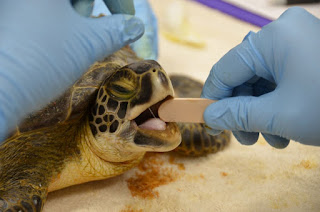 More: The most disturbing effect of anthropomorphic climate change on the world's oceans is the loss of oxygen, an absolutely necessary element for life. About half the Earth's oxygen comes from the oceans. But the combined effects of nutrient loading from discharges and climate change are greatly increasing the number and size of so-called dead zones. [map] Areas such as the Gulf of Mexico and Chesapeake Bay, oxygen levels are so low that fish suffocate and die. Of course they have learned to avoid these areas, which reduces their habitat and makes them more vulnerable to predation. Some organizes can survive in these conditions, but overall biodiversity declines. In a word, the oceans are slowing dying. The death spiral can be arrested, if man pays attention to the problem. Discharges of nitrogen from sewage and intense agriculture can be stopped. Vulnerable sea life can be protected from
unsustainable exploitation. Increased accurate monitoring of low-oxygen zones to detect increases in area and changes in oxygen content. Chesapeake Bay is good example of what can be done on a global basis. The Bay is recovering with nitrogen levels dropping 24% thanks to better sewage treatment, agricultural practice and legal protections like the Clean Air and Clean Water Acts. Once, the central Bay contained zero oxygen. That area has almost completely disappeared.
More: The most disturbing effect of anthropomorphic climate change on the world's oceans is the loss of oxygen, an absolutely necessary element for life. About half the Earth's oxygen comes from the oceans. But the combined effects of nutrient loading from discharges and climate change are greatly increasing the number and size of so-called dead zones. [map] Areas such as the Gulf of Mexico and Chesapeake Bay, oxygen levels are so low that fish suffocate and die. Of course they have learned to avoid these areas, which reduces their habitat and makes them more vulnerable to predation. Some organizes can survive in these conditions, but overall biodiversity declines. In a word, the oceans are slowing dying. The death spiral can be arrested, if man pays attention to the problem. Discharges of nitrogen from sewage and intense agriculture can be stopped. Vulnerable sea life can be protected from
unsustainable exploitation. Increased accurate monitoring of low-oxygen zones to detect increases in area and changes in oxygen content. Chesapeake Bay is good example of what can be done on a global basis. The Bay is recovering with nitrogen levels dropping 24% thanks to better sewage treatment, agricultural practice and legal protections like the Clean Air and Clean Water Acts. Once, the central Bay contained zero oxygen. That area has almost completely disappeared.
{09.01.18} PNG is following the story of global ocean warming and its impacts on coral habitats. {e.g. 30.09.13} Australia's Great Barrier Reef is suffering widespread bleaching, a phenomenon of warm seas causing corals to eject their life-sustaining symbiotic algae. Up to two-thirds of the reef has been bleached white in two consecutive years, the first recorded consecutive event, preventing corals from recovering. A unique study published in Science found that the time between bleaching events at each tropical reef location around the world diminished five-fold in the past three to four decades, from once every 25-30 years in the early 1980s to an average of just once every six years since 2010. Mass bleaching such as that now occurring on the Great Barrier did not happen before the 1980's; it has bleached four time since 1998. Despite this alarming development, the Australia government continues to support fossil fuel use; Australia has large coal deposits and exports large amounts coal to China, among other destinations.
Research funded by the Great Barrier Reef Foundation has successfully grown corals in the lab from eggs and sperm collected in the wild. The aim is to repopulate damage reefs around the world. Now, 100 larvae have been returned to the reef and are growing successfully. It is a small start, but offers hope to repairing the damaged caused to the marine environment by anthropomorphic climate change.
Ocean warming is also causing more Green turtles to become female. Already endangered, the population imbalance could drive the species to extinction. The sex of green turtles is determined by temperature of the incubating eggs. Warmer sand produces female turtles from eggs buried on the beach. ; But warm sea water also causes green turtles to change their sex. Research performed on a population of 200,000 in the northern Great Barrier Reef found that almost all had transformed into females. Scientists are looking at ways to cool incubating beaches to produce more male turtles, such as erecting tents to shield nursery beaches from the intense tropical sunlight. Once again, Nature teaches us that it takes two genders to survive.
 |
| olive ridley sea turtle, courtesy SC Aquarium |